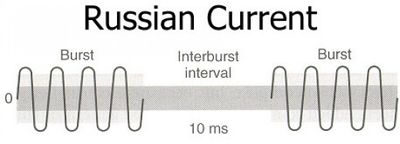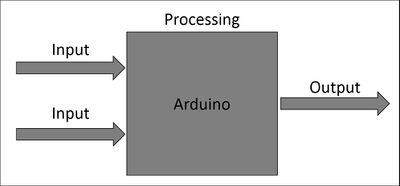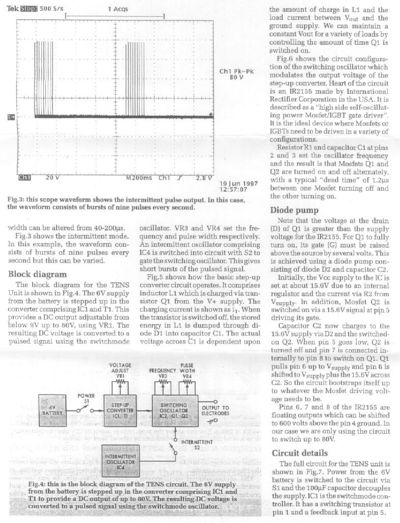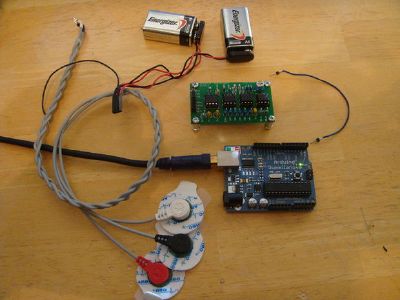No edit summary |
No edit summary |
||
| Line 5: | Line 5: | ||
'''What is Electrotherapy ?''' | '''What is Electrotherapy ?''' | ||
"Electrotherapy is the use of electrical energy as a medical treatment. When you feel nerve pain, an electrical signal is sent from a damaged nerve to your brain. These charges seem to interrupt or block the pain signals, reducing the pain you feel." (https://en.wikipedia.org/wiki/Electrotherapy) | |||
Electrotherapy units usually consist of a battery-powered device connected by wires to adhesive electrode pads which are placed on the skin. | In the article "All About Electrotherapy and Pain Relief" (2017), John P. Revord writes "Electrotherapy units usually consist of a battery-powered device connected by wires to adhesive electrode pads which are placed on the skin. [...] Once the electrodes are attached and the unit is turned on, a mild electric current is sent to the skin via the electrode. A number of newer electrotherapy devices bypass the wires, combining electrodes and battery power into a single unit that can be worn inconspicuously on the back, arm, leg, or elsewhere during work or other daily activities. A hand-held controller is used to adjust the level of stimulation." (https://www.spine-health.com/treatment/pain-management/all-about-electrotherapy-and-pain-relief) | ||
"T.E.N.S. can be used for either acute (recent or short-term) or chronic (long-term) pain. The settings on the T.E.N.S. unit can be adjusted to more effectively treat either type of pain. The two electrodes that attach to the TENS machine are called the anode and the cathode. The anode is positively charged, and sometimes represented by a + (plus) sign (sometimes coloured black). The cathode is negatively charged, and sometimes represented by a - (minus) sign (sometimes coloured red). The electrical current travels from the anode to the cathode, so the sensation is often stronger under the anode." (https://electrotherapist.blogspot.com/2008/07/uses-of-electrotherapy.html) | |||
"The ‘Gate Control’ theory was first proposed in 1965. The main concept of this theory is that the brain can only pay attention to one stimulus (or message) at a time. When a painful stimulus causes a pain receptor (specialized cell that detects painful stimuli) to send a message to the brain via a ‘pain nerve’, the brain perceives that message as ‘pain’. Similarly, if a touch receptor is stimulated, a message is sent to the brain by a ‘touch nerve’ so that the brain perceives that message as ‘touch’ rather than pain. [...] T.E.N.S. also works by this method. The appropriate electrical signal stimulates the touch receptors, and via a bit of fancy signaling in the spinal cord, the pain message is not acknowledged by the brain. [...] It simply provides a “rest from pain” to permit you to move better and thus assist the body in getting the nutrition and activity that it needs to complete the healing of the painful area both at rest and during appropriate exercises. [...] | |||
The other way that T.E.N.S. works to relieve pain is by stimulating the release of natural chemicals in the body which the body usually releases when there is injury or stress. The chemical substances released are known as endorphins and enkephalins. The T.E.N.S. unit can be adjusted to selectively stimulate the release of either enkephalins or endorphins. The small electrical signal which is developed by the T.E.N.S. device is delivered to the body by specialized pads called electrodes." (https://electrotherapist.blogspot.com/2008/07/uses-of-electrotherapy.html) | |||
'''Types of Electrotherapy''' | '''Types of Electrotherapy''' | ||
All electrotherapy devices have certain similarities, such as using battery power to apply current to electrodes. The therapies vary in frequencies, waveforms, and effects, however. These are some of the most commonly used kinds of electrotherapy: | In the Article "How Electrotherapy Works to Ease Pain" (2017), John P. Revord writes "All electrotherapy devices have certain similarities, such as using battery power to apply current to electrodes. The therapies vary in frequencies, waveforms, and effects, however. These are some of the most commonly used kinds of electrotherapy: | ||
Transcutaneous electrical nerve stimulation (TENS) | Transcutaneous electrical nerve stimulation (TENS) | ||
| Line 22: | Line 23: | ||
Interferential current (IFC) | Interferential current (IFC) | ||
Pulsed electromagnetic field therapy (PEMF) | Pulsed electromagnetic field therapy (PEMF) | ||
Galvanic stimulation (GS) | Galvanic stimulation (GS)" | ||
'''Benefits of Electrotherapy ''' | '''Benefits of Electrotherapy ''' | ||
Electrotherapy | In the Article "All About Electrotherapy and Pain Relief" (https://www.spine-health.com/treatment/pain-management/all-about-electrotherapy-and-pain-relief), John P. Revord writes "Electrotherapy has been used to address chronic pain and chronic fatigue in general, as well as: | ||
Electrotherapy has been used to address chronic pain and chronic fatigue in general, as well as: | |||
*Diabetic nerve pain | *Diabetic nerve pain | ||
| Line 67: | Line 56: | ||
*Reflex Sympathetic Dystrophy (RSD) | *Reflex Sympathetic Dystrophy (RSD) | ||
*Acute Herpes Zoster/Post Herpetic Neuralgia | *Acute Herpes Zoster/Post Herpetic Neuralgia | ||
* Rheumatoid Arthritis (RA) | * Rheumatoid Arthritis (RA)" | ||
'''Side Effects of Electrotherapy''' | '''Side Effects of Electrotherapy''' | ||
Mike Williams writes in 2016 (http://blog.ireliev.com/tens-unit-side-effects) : | |||
*Burn Marks | |||
*Damage to Open Wounds | |||
*If TENS unit pads are placed on or too close to open wounds or damaged skin, the wound can become further irritated. The wound may also take longer to heal. Because of this, avoid placing electrode pads on or near damaged skin | |||
*Potential fetal harm | |||
*Muscle Pain and soreness | |||
*Loss of muscular control | |||
*Unpleasant electric shocks to the Skin | |||
'''THREE basic modes of relieving pain with T.E.N.S.''' (https://electrotherapist.blogspot.com/2008/07/history-of-electrotherapy.html) | |||
'''THREE basic modes of relieving pain with T.E.N.S.''' | |||
CONTINUOUS (Constant or Normal)- | CONTINUOUS (Constant or Normal)- | ||
The standard T.E.N.S. treatment (also known as "conventional" or "high-frequency") is performed when the Pulse Rate is set to 60-100 pulses per second or more (in this method, rate, width (usually 200mcsec - and intensity settings are fully adjustable). It is thought that in this mode, pain relief is achieved through the gate control theory. The sensation produced with this setting can be described as a steady "buzzing" or "tingling" feeling between the electrodes. At this frequency the unit produces an electrical signal that is stronger than the pain signal that the body produces. Because the signal is perceived as stronger, it effectively blocks the pain signal from traveling along nerves to the brain. Most patients find that high-frequency treatments produce the quickest relief from pain, as well as providing hours of relief after the treatment if it is long enough . | "The standard T.E.N.S. treatment (also known as "conventional" or "high-frequency") is performed when the Pulse Rate is set to 60-100 pulses per second or more (in this method, rate, width (usually 200mcsec - and intensity settings are fully adjustable). It is thought that in this mode, pain relief is achieved through the gate control theory. The sensation produced with this setting can be described as a steady "buzzing" or "tingling" feeling between the electrodes. At this frequency the unit produces an electrical signal that is stronger than the pain signal that the body produces. Because the signal is perceived as stronger, it effectively blocks the pain signal from traveling along nerves to the brain. Most patients find that high-frequency treatments produce the quickest relief from pain, as well as providing hours of relief after the treatment if it is long enough." | ||
BURST - | BURST - | ||
A "low-frequency" or "burst" type treatment is produced when the Pulse Rate setting on the T.E.N.S. unit is below 10 pulses per second ie. 2Hz (set manually) or at "burst" mode (automatic) (in this mode, width (often set at 200mcsec) and intensity settings are fully adjustable, however, the rate setting is not adjustable). Low-frequency treatments are done at an intensity that produces visible muscle twitching. The sensation at these settings is described as a "tapping" or "pulsating" feeling. The body reacts to this type of stimulation by releasing "endorphins" (pain-killing chemicals produced naturally in the body). These endorphins act as a chemical nerve block, effectively reducing pain by interrupting the flow of pain signals along the nerves. Patients find that this type of treatment sometimes takes longer to be effective (30 to 45 minutes), but once pain relief is experienced, it lasts for a longer period of time . | "A "low-frequency" or "burst" type treatment is produced when the Pulse Rate setting on the T.E.N.S. unit is below 10 pulses per second ie. 2Hz (set manually) or at "burst" mode (automatic) (in this mode, width (often set at 200mcsec) and intensity settings are fully adjustable, however, the rate setting is not adjustable). Low-frequency treatments are done at an intensity that produces visible muscle twitching. The sensation at these settings is described as a "tapping" or "pulsating" feeling. The body reacts to this type of stimulation by releasing "endorphins" (pain-killing chemicals produced naturally in the body). These endorphins act as a chemical nerve block, effectively reducing pain by interrupting the flow of pain signals along the nerves. Patients find that this type of treatment sometimes takes longer to be effective (30 to 45 minutes), but once pain relief is experienced, it lasts for a longer period of time." | ||
MODULATED - | MODULATED - | ||
Pulse width is automatically varied in a cyclic pattern at intervals of 6 seconds. The modulation range of pulse width varies from the control setting value to 40% less than that value. Rate, width and intensity are fully adjustable. Modulation of the T.E.N.S. output parameters (width, rate and amplitude) may prevent the nervous system from accommodating to the continuous mode of T.E.N.S., thus improving duration of pain relief. | "Pulse width is automatically varied in a cyclic pattern at intervals of 6 seconds. The modulation range of pulse width varies from the control setting value to 40% less than that value. Rate, width and intensity are fully adjustable. Modulation of the T.E.N.S. output parameters (width, rate and amplitude) may prevent the nervous system from accommodating to the continuous mode of T.E.N.S., thus improving duration of pain relief." | ||
'''Waveform''' | '''Waveform''' | ||
Sarah Zuboff writes in 2016 (https://www.prohealthcareproducts.com/blog/benefits-of-electrotherapy-in-physical-therapy/) : | |||
The Russian Current waveform delivers medium frequency in alternating pulses of energy. This makes it a popular waveform to use when there is a need to increase muscle strength and re-educate specific areas. The Russian current can also stimulate the relief of pain-relieving endorphins, increasing its versatility and applications. | "The Russian Current waveform delivers medium frequency in alternating pulses of energy. This makes it a popular waveform to use when there is a need to increase muscle strength and re-educate specific areas. The Russian current can also stimulate the relief of pain-relieving endorphins, increasing its versatility and applications." | ||
[[File:400px-Russian-current-waveform-used-in-stimulation-therapy.jpg|400px]] | [[File:400px-Russian-current-waveform-used-in-stimulation-therapy.jpg|400px]] | ||
"Interferential Current (also referred to as IFC) is the waveform to use when treating chronic, post-surgical and post-trauma acute pain. IFC e-stim is non-invasive with minimal side effects. IFC delivers higher frequency energy so it crosses the skin barrier easier for deeper access into areas of pain, but also has improved tolerance." | |||
Interferential Current (also referred to as IFC) is the waveform to use when treating chronic, post-surgical and post-trauma acute pain. IFC e-stim is non-invasive with minimal side effects. IFC delivers higher frequency energy so it crosses the skin barrier easier for deeper access into areas of pain, but also has improved tolerance. | |||
Premodulated Current, also referred to as “premod”, is similar to interferential current. The main difference is that with premod current, a single channel is used to mix the frequencies prior to before current reaches the patient. This makes it a good choice when treating smaller areas of the body like: elbows, ankles, feet, or hands. | "Premodulated Current, also referred to as “premod”, is similar to interferential current. The main difference is that with premod current, a single channel is used to mix the frequencies prior to before current reaches the patient. This makes it a good choice when treating smaller areas of the body like: elbows, ankles, feet, or hands." | ||
""Biphasic" has two pulses of 2 different intensities. These alternate during treatment which makes it very versatile. Biphasic can be used for both acute and chronic problems for different goals including: | |||
"Biphasic" has two pulses of 2 different intensities. These alternate during treatment which makes it very versatile. Biphasic can be used for both acute and chronic problems for different goals including: | |||
Strengthening & re-educating muscles | Strengthening & re-educating muscles | ||
Improving blood circulation | Improving blood circulation | ||
Decreasing edema & swelling | Decreasing edema & swelling" | ||
High Voltage | "High Voltage electrical stimulation is a monophasic waveform which uses polarity (positive or negative) to stimulate the tissue. This is a popular modality to aid in decreasing pain and swelling, reducing muscle spasms and facilitating wound healing." | ||
"Microcurrent is also used for wound healing, utilizing micro-size, pulsing current. Because of its low intensity, microcurrent is the most tolerated waveform in electrotherapy." | |||
'''Measure''' | |||
Measure | |||
Intensity: A dial allows the user to adjust the intensity of the electrical stimulation. | Intensity: A dial allows the user to adjust the intensity of the electrical stimulation. | ||
| Line 243: | Line 118: | ||
'''Electrotherapy with Arduino''' | '''Electrotherapy with Arduino''' | ||
Schema : | Schema : | ||
Revision as of 11:25, 25 June 2019
Electrotherapy made simple : https://www.youtube.com/watch?v=JAPU5iEfFVY
What is Electrotherapy ?
"Electrotherapy is the use of electrical energy as a medical treatment. When you feel nerve pain, an electrical signal is sent from a damaged nerve to your brain. These charges seem to interrupt or block the pain signals, reducing the pain you feel." (https://en.wikipedia.org/wiki/Electrotherapy)
In the article "All About Electrotherapy and Pain Relief" (2017), John P. Revord writes "Electrotherapy units usually consist of a battery-powered device connected by wires to adhesive electrode pads which are placed on the skin. [...] Once the electrodes are attached and the unit is turned on, a mild electric current is sent to the skin via the electrode. A number of newer electrotherapy devices bypass the wires, combining electrodes and battery power into a single unit that can be worn inconspicuously on the back, arm, leg, or elsewhere during work or other daily activities. A hand-held controller is used to adjust the level of stimulation." (https://www.spine-health.com/treatment/pain-management/all-about-electrotherapy-and-pain-relief)
"T.E.N.S. can be used for either acute (recent or short-term) or chronic (long-term) pain. The settings on the T.E.N.S. unit can be adjusted to more effectively treat either type of pain. The two electrodes that attach to the TENS machine are called the anode and the cathode. The anode is positively charged, and sometimes represented by a + (plus) sign (sometimes coloured black). The cathode is negatively charged, and sometimes represented by a - (minus) sign (sometimes coloured red). The electrical current travels from the anode to the cathode, so the sensation is often stronger under the anode." (https://electrotherapist.blogspot.com/2008/07/uses-of-electrotherapy.html)
"The ‘Gate Control’ theory was first proposed in 1965. The main concept of this theory is that the brain can only pay attention to one stimulus (or message) at a time. When a painful stimulus causes a pain receptor (specialized cell that detects painful stimuli) to send a message to the brain via a ‘pain nerve’, the brain perceives that message as ‘pain’. Similarly, if a touch receptor is stimulated, a message is sent to the brain by a ‘touch nerve’ so that the brain perceives that message as ‘touch’ rather than pain. [...] T.E.N.S. also works by this method. The appropriate electrical signal stimulates the touch receptors, and via a bit of fancy signaling in the spinal cord, the pain message is not acknowledged by the brain. [...] It simply provides a “rest from pain” to permit you to move better and thus assist the body in getting the nutrition and activity that it needs to complete the healing of the painful area both at rest and during appropriate exercises. [...] The other way that T.E.N.S. works to relieve pain is by stimulating the release of natural chemicals in the body which the body usually releases when there is injury or stress. The chemical substances released are known as endorphins and enkephalins. The T.E.N.S. unit can be adjusted to selectively stimulate the release of either enkephalins or endorphins. The small electrical signal which is developed by the T.E.N.S. device is delivered to the body by specialized pads called electrodes." (https://electrotherapist.blogspot.com/2008/07/uses-of-electrotherapy.html)
Types of Electrotherapy
In the Article "How Electrotherapy Works to Ease Pain" (2017), John P. Revord writes "All electrotherapy devices have certain similarities, such as using battery power to apply current to electrodes. The therapies vary in frequencies, waveforms, and effects, however. These are some of the most commonly used kinds of electrotherapy:
Transcutaneous electrical nerve stimulation (TENS) Percutaneous electrical nerve stimulation (PENS) Electrical muscle stimulation (EMS) Interferential current (IFC) Pulsed electromagnetic field therapy (PEMF) Galvanic stimulation (GS)"
Benefits of Electrotherapy
In the Article "All About Electrotherapy and Pain Relief" (https://www.spine-health.com/treatment/pain-management/all-about-electrotherapy-and-pain-relief), John P. Revord writes "Electrotherapy has been used to address chronic pain and chronic fatigue in general, as well as:
- Diabetic nerve pain
- Fibromyalgia
- Migraine headaches
- Wound healing
- Stimulating bone growth
- Acute and chronic ankle pain and ankle joint arthritis
- Acute and chronic low back pain associated with spinal nerve and disc pain or spinal osteoarthritis/degenerative disc disease (DDD)
- Acute and chronic neck pain associated with soft tissue injury to the muscles, ligaments or spinal discs, joint inflammation and spinal arthritis
- Acute, chronic and post surgical knee pain associated with muscle, tendon, ligament or joint arthritis problems
- Acute and chronic shoulder pain associated with muscle, tendon, ligament or shoulder joint arthritis
- Carpal tunnel syndrome – pain associated with compression of the nerves in the carpal tunnel
- Foot pain including Plantar Fasciitis, Achilles Tendinopathy, Morton’s Neuroma and Peripheral Neuropathy
- Post lumbar laminectomy – a type of surgery to the spine
- Dental pain including TMJ pain (jaw joint)
- Facial paralysis
- Trigeminal Neuralgia
- Hip pain
- Post-operative pain
- Sciatica
- Bicipital tendonitis
- Tennis elbow
- Wrist pain
- Shin splints
- Diabetes neuropathy
- Degenerative Joint Disease (DJD)
- Reflex Sympathetic Dystrophy (RSD)
- Acute Herpes Zoster/Post Herpetic Neuralgia
- Rheumatoid Arthritis (RA)"
Side Effects of Electrotherapy
Mike Williams writes in 2016 (http://blog.ireliev.com/tens-unit-side-effects) :
- Burn Marks
- Damage to Open Wounds
- If TENS unit pads are placed on or too close to open wounds or damaged skin, the wound can become further irritated. The wound may also take longer to heal. Because of this, avoid placing electrode pads on or near damaged skin
- Potential fetal harm
- Muscle Pain and soreness
- Loss of muscular control
- Unpleasant electric shocks to the Skin
THREE basic modes of relieving pain with T.E.N.S. (https://electrotherapist.blogspot.com/2008/07/history-of-electrotherapy.html)
CONTINUOUS (Constant or Normal)-
"The standard T.E.N.S. treatment (also known as "conventional" or "high-frequency") is performed when the Pulse Rate is set to 60-100 pulses per second or more (in this method, rate, width (usually 200mcsec - and intensity settings are fully adjustable). It is thought that in this mode, pain relief is achieved through the gate control theory. The sensation produced with this setting can be described as a steady "buzzing" or "tingling" feeling between the electrodes. At this frequency the unit produces an electrical signal that is stronger than the pain signal that the body produces. Because the signal is perceived as stronger, it effectively blocks the pain signal from traveling along nerves to the brain. Most patients find that high-frequency treatments produce the quickest relief from pain, as well as providing hours of relief after the treatment if it is long enough."
BURST -
"A "low-frequency" or "burst" type treatment is produced when the Pulse Rate setting on the T.E.N.S. unit is below 10 pulses per second ie. 2Hz (set manually) or at "burst" mode (automatic) (in this mode, width (often set at 200mcsec) and intensity settings are fully adjustable, however, the rate setting is not adjustable). Low-frequency treatments are done at an intensity that produces visible muscle twitching. The sensation at these settings is described as a "tapping" or "pulsating" feeling. The body reacts to this type of stimulation by releasing "endorphins" (pain-killing chemicals produced naturally in the body). These endorphins act as a chemical nerve block, effectively reducing pain by interrupting the flow of pain signals along the nerves. Patients find that this type of treatment sometimes takes longer to be effective (30 to 45 minutes), but once pain relief is experienced, it lasts for a longer period of time."
MODULATED -
"Pulse width is automatically varied in a cyclic pattern at intervals of 6 seconds. The modulation range of pulse width varies from the control setting value to 40% less than that value. Rate, width and intensity are fully adjustable. Modulation of the T.E.N.S. output parameters (width, rate and amplitude) may prevent the nervous system from accommodating to the continuous mode of T.E.N.S., thus improving duration of pain relief."
Waveform
Sarah Zuboff writes in 2016 (https://www.prohealthcareproducts.com/blog/benefits-of-electrotherapy-in-physical-therapy/) :
"The Russian Current waveform delivers medium frequency in alternating pulses of energy. This makes it a popular waveform to use when there is a need to increase muscle strength and re-educate specific areas. The Russian current can also stimulate the relief of pain-relieving endorphins, increasing its versatility and applications."
"Interferential Current (also referred to as IFC) is the waveform to use when treating chronic, post-surgical and post-trauma acute pain. IFC e-stim is non-invasive with minimal side effects. IFC delivers higher frequency energy so it crosses the skin barrier easier for deeper access into areas of pain, but also has improved tolerance."
"Premodulated Current, also referred to as “premod”, is similar to interferential current. The main difference is that with premod current, a single channel is used to mix the frequencies prior to before current reaches the patient. This makes it a good choice when treating smaller areas of the body like: elbows, ankles, feet, or hands."
""Biphasic" has two pulses of 2 different intensities. These alternate during treatment which makes it very versatile. Biphasic can be used for both acute and chronic problems for different goals including: Strengthening & re-educating muscles Improving blood circulation Decreasing edema & swelling"
"High Voltage electrical stimulation is a monophasic waveform which uses polarity (positive or negative) to stimulate the tissue. This is a popular modality to aid in decreasing pain and swelling, reducing muscle spasms and facilitating wound healing."
"Microcurrent is also used for wound healing, utilizing micro-size, pulsing current. Because of its low intensity, microcurrent is the most tolerated waveform in electrotherapy."
Measure
Intensity: A dial allows the user to adjust the intensity of the electrical stimulation. Frequency: The frequency refers to the number of electrical pulses per second. High-frequency (HF) pulses range from 80 to 120 cycles per second and may help manage acute pain. Low-frequency (LF) pulses range from 1 to 20 cycles per second and are suitable for the treatment of chronic pain. Duration: The duration is the number of microseconds that the current enters the skin for during each pulse.
Electrotherapy with Arduino
Schema :



